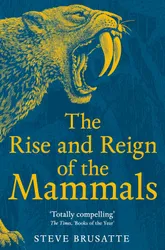This book is a follow-up to The Rise and Fall of the Dinosaurs, the author having taken more of an interest in mammal palaeontology since that book was published. It takes a similar approach to that earlier tome, covering fossil discoveries and DNA evidence, while telling the story of the development of mammals throughout their evolutionary history.
The story starts in the Carboniferous period, with mammals branching off from reptiles. The ancestors of modern mammals were still egg laying, scaly, hairless creatures at this time, and I was interested to learn that egg laying in mammals persisted for a long time. In fact, monotremes like the duck-billed platypus and echidnas still lay eggs today.
During the period when dinosaurs dominated the earth, the niches for large animals were all occupied. So it was only smaller mammals that lived at this time, but the book makes the case that there was a wide variety of different small mammals around. Just as in the author’s book about dinosaurs, a key moment in the story is the asteroid that hit the earth at the end of the Cretaceous period. While it wiped out all the non-avian dinosaurs, and a large number of mammals as well, those mammals that survived were given an opportunity to take over the earth in the dinosaurs’ place.
The book covers many of the factors that resulted in mammals being dispersed all over the globe, and how they became so diverse. These factors include geological changes, like continents moving around, and climatic changes such as ice ages. One significant change for mammals was the evolution of grasses, which gradually began to replace forests. This opened up a new niche for grazing mammals to occupy, and they evolved the changes to teeth and digestive systems required to take advantage of this new food source. The increase in grasslands at the expense of forests may also have been a factor in humans’ tree dwelling ancestors beginning to live on the ground and developing the upright walking posture that we have today.
One thing that surprised me was to learn how important fossilised teeth are in our understanding of mammal evolution. Changes to lifestyle and diet result in changes to teeth, and some of these changes are inherited by descendants even if their diet changes again later on. So the types and shapes of teeth are very indicative of both the diet that an animal consumed, and the part of the family tree that animal is from. There are even cases where a single fossilised tooth has been enough to identify a new species!
As well as fossil evidence, this book talks a lot about DNA evidence. In some cases, scientists have been able to extract and sequence DNA from well-preserved specimens, and we can use the DNA of extant creatures to help us build up the mammalian family tree. This book certainly covers more of the role of DNA in constructing these family trees than Written in Stone did.
As in The Rise and Fall of the Dinosaurs, the book contains extensive photographs, diagrams and sketches which really help to clarify understanding. The writing is engaging and clear, and I can’t really imagine a better book about the evolution of mammals.
